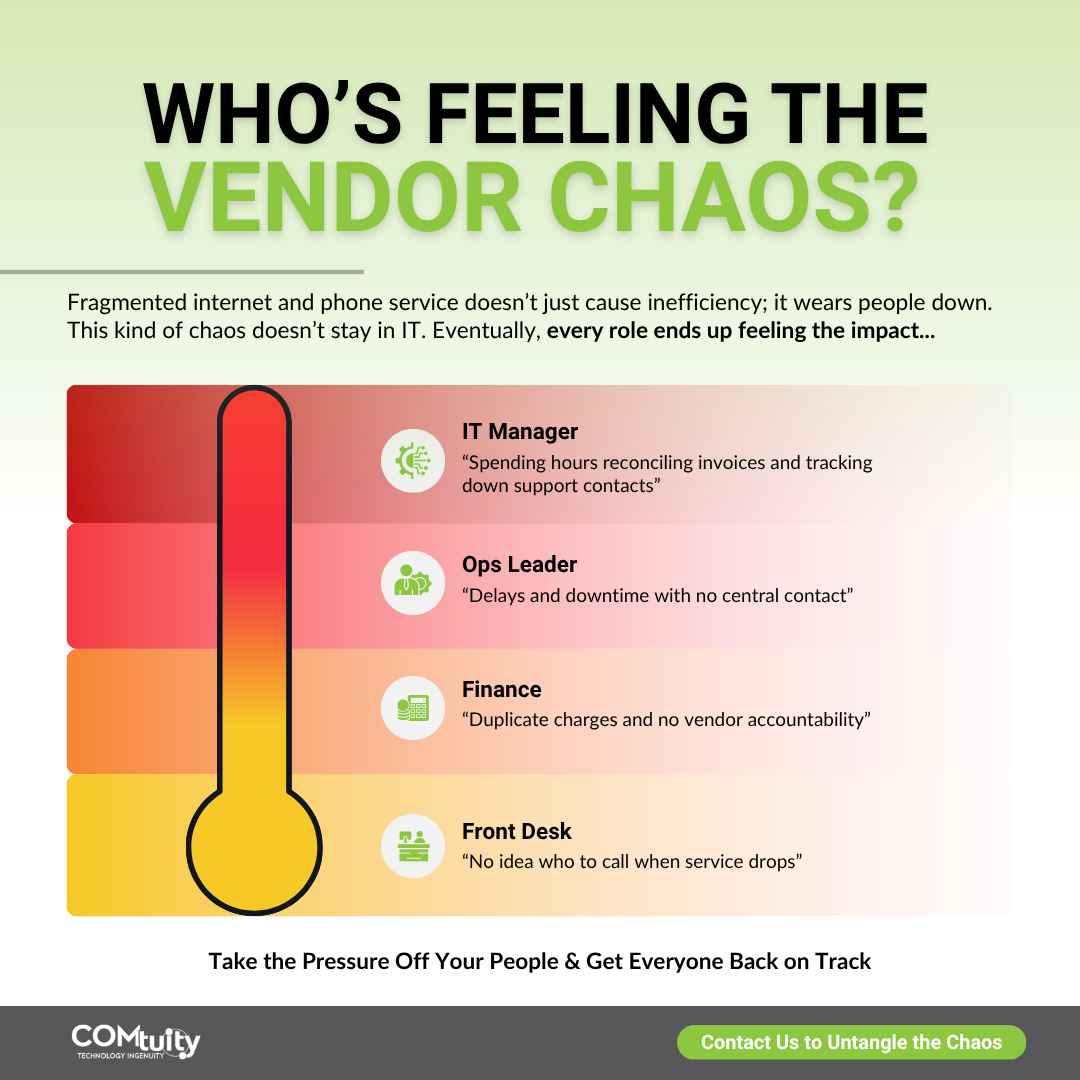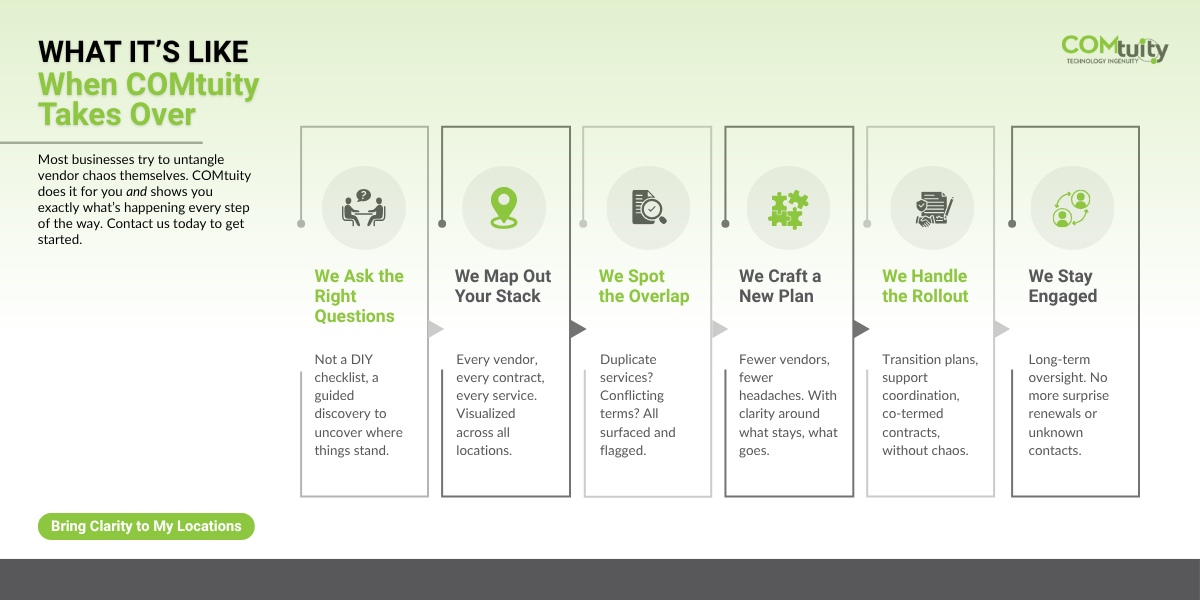At a glance, it doesn’t seem like a big deal. A business adds a new location and signs up with whatever internet and phone service provider can get it up and running quickly. Maybe the manager on-site made the call. Maybe a quick recommendation turned into a multi-year contract. And just like that, another vendor joins the list.
Now multiply that by 20 or 30 locations over several years.
It’s easy for this process to feel normal, even efficient. Each site gets what it needs, things stay up and running, and the team keeps moving. But behind the scenes, something else is building. Layer after layer of disconnected service, incomplete records, and inconsistent support.
Before long, you’re no longer sure which vendor covers which location. Some sites are on premium plans with priority support; others are running on outdated infrastructure with no escalation path. Your IT team fields complaints about dropped calls or unstable Wi-Fi and spends hours just trying to figure out who to contact.
Invoices arrive from different vendors at different times with different terms. Nobody’s sure which services are redundant or inactive. And when outages happen, the first hour is often spent trying to confirm the account number and service level before anyone can even begin troubleshooting.
This is vendor sprawl. And it’s not just a minor annoyance. It’s a hidden source of wasted spend, team burnout, and operational drag.
In this blog, we’ll explore how a team of experienced advisors can turn this messy, hard-to-manage vendor space into something clear, consistent, and built to support how your business operates.
Before we get into how COMtuity fixes the chaos, let’s look at who it impacts most.
Take a look at how that strain shows up across your team.
The “Before” – What We Usually Find
When businesses reach out for help, what they describe is rarely a tech problem. It’s a time problem. A clarity problem. A frustration that something simple has somehow become complicated, and no one has the capacity to deal with it.
Here’s what we typically walk into:
1. Disconnected and Bloated Vendor Lists
Most businesses have accumulated a long list of providers over time. Some were chosen by local staff during a site launch. Others were part of bundled hardware deals or left over from acquired entities.
There’s usually no centralized record, no way to tell who’s managing which location, and no clear reason why certain vendors are still active.
2. Scattered, Outdated Contracts and Billing Chains
We often see services still active at closed sites or multiple internet services at the same location, only one of which is actually in use. Voice lines linger months after a cloud migration.
Invoices land in inboxes no one checks, and late fees build on accounts no one realized were still open.
3. Unreliable Service Levels Across Locations
Some locations enjoy consistent speeds and responsive support. Others face laggy connections, poor call quality, or support reps who escalate nothing.
This mix creates uneven experiences across teams—and no one can explain why things work well in one city and break down in another.
4. No Single Owner, No Coordinated Oversight
No department fully owns the issue. IT puts out fires, Finance sees the charges, and local leaders manage what they can. Everyone is touching the problem, but no one has the full view.
Without that ownership, issues linger. Fixes are delayed or incomplete because nobody is tasked with sorting through the entire picture.
5. Low-Level Friction That Wears People Down
Even when it’s not a crisis, this kind of sprawl causes pressure. Projects take longer. Teams work around known issues instead of raising them. Leaders answer for outages they didn’t know were coming.
Stress builds slowly, showing up in missed deadlines, avoidable backlogs, and team members stretched thin.
All of these patterns share 1 thing in common: you’re now carrying the cost of fragmented decisions made under pressure. That can change.
The Turning Point – When COMtuity Steps In
The tipping point varies. Sometimes, it’s a location that goes dark with no warning and no clear path to escalate support. Sometimes, it’s finance flagging a 20% year-over-year spike in telecom spend. Other times, it’s a string of daily complaints that finally reach leadership and they ask, “Why is this still a problem?”
That moment of friction creates a window. And that’s when the right partner like COMtuity can make all the difference.
Once you bring us in, here’s how we move:
Step One: Discovery Without Disruption
The first step is clarity. Before anything can be optimized, you need to know exactly what’s in place and where. That starts with a comprehensive inventory of your internet and phone services across all locations. We look at what services are active, who’s providing them, and how they’re being billed.
This process doesn’t require much from your team. If you can share recent invoices, vendor names, or even just email threads, we’ll take it from there. We handle the calls, the digging, and the sorting. No disruption, no back-and-forth. While your team stays focused on daily work, we work behind the scenes to build a clean, accurate view of your current state, so every decision that follows is based on facts, not assumptions.
This kind of structured visibility is foundational, not just for vendor clarity, but for long-term IT standardization across your operations. Here’s how COMtuity helps create that larger framework, location by location.
Step Two: Lifecycle Audit and Gap Assessment
We track every detail: who your providers are, which services are active at each site, when contracts expire, what your SLAs promise, and how those promises are holding up. Along the way, we flag weak points like unmanaged renewals, missing failover connections, and buried fees.
Then we ask the questions that uncover real opportunity:
- Where are you overpaying—for speed you don’t use, lines you don’t need, or bundled extras no one asked for?
- Where are your teams under-supported, waiting too long for basic fixes or stuck in endless escalations?
- Where do services overlap or remain active despite being unused?
- Are there contracts renewing without review or services billed to closed locations?
- What would it take to bring everything under one simplified structure?
By the end of this step, you’re looking at your environment with fresh eyes and you’ll finally have the clarity to act.
Step Three: Actionable Recommendations
We bring forward options that align with how you operate—nothing cookie-cutter or forced. Every recommendation is designed to simplify, strengthen, or save.
What you might see:
- Consolidated vendor list with clear escalation paths across all sites
- Standardized internet speeds and voice plans tailored to your use case
- Reduced spend through regional contracts and bulk pricing
- Retired legacy lines and inactive services you no longer use
- One billing statement, one support line, and one source of truth
And you don’t have to run point on any of it. We coordinate with vendors, handle the paperwork, manage transitions, and keep your teams informed along the way. What used to be a mess becomes manageable. What used to drain time and energy starts working the way it should.
At every step, our goal is the same: reduce friction, bring clarity, and give your team room to focus. Here’s how our process plays out from start to finish.
The “After” – Clarity, Control, and Relief
Once everything’s cleaned up, the change is immediate and steady. You’re not chasing invoices, sorting through vague contracts, or fielding the same complaints week after week. The guesswork is gone, and so is the strain it used to cause.
Here’s what the new normal looks like:
1. Central Visibility
You finally have a clear picture. Every service, contract, and cost is mapped out. You know which vendor supports each location, and everyone on your team does too.
No more delays caused by missing info or hidden details. What used to take hours to piece together is now at your fingertips.
2. Smarter Spend
You’re not throwing money at services you don’t use. Every dollar supports something active, necessary, and aligned with how your teams work. That means you’re getting value—not just paying bills.
Many businesses save 20–30% by trimming what they don’t need. But more importantly, you’re no longer paying for confusion.
3. Reliable Support
When something breaks, your team knows exactly who to call. No more phone trees, no more finger-pointing. Escalations move faster because support knows what’s in place and where.
This saves time, protects uptime, and keeps issues from getting worse while people figure out what to do.
4. More Capacity for Your Team
Your internal teams finally get breathing room. IT isn’t stuck chasing vendors or tracking mystery charges. They get back to focusing on real strategy and meaningful work.
Finance has what they need to reconcile bills quickly. Ops stops running interference every time a location has an issue.
5. Confidence to Grow
Expanding no longer adds clutter. Each new site follows the same clear model—no improvising, no last-minute vendor hunts. It all just works.
That consistency gives you the confidence to move quickly without creating more chaos behind the scenes.
You’ll feel the difference. Not in big, flashy ways but in smoother projects, quieter inboxes, and fewer questions that no one can answer. What used to be an unmanaged tangle is now something calm, consistent, and under control.
Get Clarity Without the Heavy Lift
You don’t need to live in the dark about your internet and phone service footprint. And you don’t need to assign your team to a six-month internal cleanup project just to get answers. This is what COMtuity does.
We step into the chaos, map it clearly, clean it up, and keep it that way. You don’t just get reports, you get resolution. We stay involved, we stay accountable, and we act as your partner at every step. No gaps. No guessing. No added strain on your team.
If what you just read feels familiar—if you’ve got more vendors than visibility, and more pain than performance, now is the right time to ask for help.
Let’s simplify this. It starts with a conversation. Book a free consultation here.





